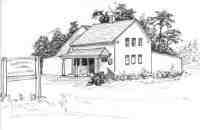As the ice was cut, it was pulled
out of the pond by a horse. There was a rope on a
wheel that was something like a clothesline pulley.
The rope was attached to the horse and went to a
hook that was on the ice. The horse walked along the
edge of the pond and drew the ice into the special
house where it was stored.
The LeMays icehouse had a space
between the walls of the ice house and the ice. The
ice was stacked up and covered with sawdust. This
method kept the ice from melting all through the
summer.
It took two days to harvest the ice
from the pond. During a really cold year, ice could
be harvested more than once during the same year.
Ten, twelve or fourteen men were in
an ice harvesting crew. Some of the Harpswell men
that worked at LeMay's pond were the Bibbers,
Merrimans, and Chipmans. Arnold's mother was the
only woman that helped. At age nine or ten Arnold
started to help with the cleaning of the pond. At
age fourteen or fifteen he began to help with the
harvesting. It was a family chore and he didn't get
paid.
Arnold liked cutting ice because it
was something different to do and it was also a
social time. It was sometimes dangerous because you
could fall in the pond or get hit by a block of ice.
Once George Allen fell in the pond and all of his
clothes were frozen like ice. It was a scary time
for him. He went in the LeMays house for a while and
then was taken home.
The LeMays delivered ice to all
parts of Harpswell Neck. People also came to the
house to buy ice. The price of the ice was decided
upon by the weight and by the thickness. Arnold
remembers it being two cents a pound, but the price
may have been different at other times.
Besides delivering ice to Harpswell
homes, the LeMays also sold ice to places such as
Auburn Colony, Merriconeag House, Guernsey Villa,
Ocean View Hotel, and Lookout Point House.
Before there were refrigerators,
people used iceboxes. Iceboxes were made out of wood
and were usually lined with zinc. A big chunk of ice
was put in the top part of the box. Some people
wrapped their ice in newspaper to make it last
longer. As the ice melted, the water would go into a
pipe and then flow into a pan at the bottom of the
ice box. If the ice box was in the shed, the water
sometimes went into the ground.
If people didn't have an icebox,
they used to keep their food cool by putting ice in
a pail or bucket and lowering it into a dug well or
cold stream. In winter they put food in a box and
put the box outside or in a cold room.
The Will Dunning family, the
Millers, and Laurence Merriman family harvested ice,
but only for their own use. The Dunnings and
Merrimans needed a lot of ice on their farms and the
Millers for their inn. Ed Hayes Moody on Basin Point
sold and delivered ice the same as the LeMays. On
the other side of town a lot of ice was produced at
Dingley Island.
For several years after he was
married Arnold LeMay still helped with ice
harvesting. The family stopped ice harvesting in the
early fifties. By then most people had electric
refrigerators and not much ice was needed.

